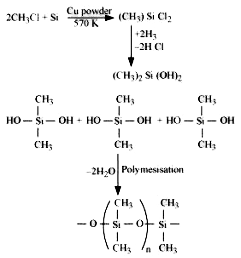Explain the following reactions
(a) Silicon is heated with methyl chloride at high temperature in the presence of copper,
(b) Silicon dioxide is treated with hydrogen fluoride,
(c) CO is heated with ZnO,
(d) Hydrated alumina is treated with aqueous NaOH solution.
(a) When silicon reacts with methyl chloride in the presence of copper (catalyst) and at a temperature of about 537 K, a class of organosilicon polymers called methyl- substituted chlorosilanes (MeSiCl3,Me2SiCl2,Me3SiCl, and Me4Si) are formed.

(b) When silicon dioxide (SiO2) is heated with hydrogen fluoride (HF), it forms silicon tetrafluoride (SiF4). Usually, the Si–O bond is a strong bond and it resists any attack by halogens and most acids, even at a high temperature. However, it is attacked by HF.
SiO2+4HF→SiF4+2H2O
The SiF4 formed in this reaction can further react with HF to form hydrofluorosilicic acid.
SiF4+2HF→H2SiF6
(c) When CO reacts with ZnO, it reduces ZnO to Zn. CO acts as a reducing agent.
ZnO(s)+CO(g)Δ−−→Zn(s)+CO2(g)
(d) When hydrated alumina is added to sodium hydroxide, the former dissolves in the latter because of the formation of sodium meta-aluminate.
Al2O3.2H2O+2NaOH→2NaAlO2+3H2O
Topper's Solved these Questions
Similar Questions
Explain the following reactions :
(i) CO is heated with ZnO.
(ii) Hydrated alumina is heated with aqueous NaOH.
(iii) Silicon is heated with methyl chloride at high temperature in the presence of copper.View SolutionComplete the following reactions
(a) An alkaline solution of potassium ferricyanide is treated with hydrogen peroxide.
(b) Chromium hydroxide is treated with hydrogen peroxide in the presence of NaOH.View SolutionName the final product of the following reactions : (i) Benzene is treated with methyl chloride in presence of anhydrous aluminium chloride.
(ii) Benzene is treated with acetyl chloride in the presence of anhydrous aluminium chloride.
(iii) Phenol is heated with zinc.
(iv) Sodium benzoate is heated with soda lime.
(v) Benzene is treated with fumining nitric acid in presence of conc. H2SO4.
(vi) Benzene is catalytically hydrogenated. (vii) Ozone reacts with benzene. (viii) Toluene is treated with a mixture of conc. CNO3 and conc. H2SO4.
(ix) Chlorine is passed through boiling toluene. (x) Toluene is heated with acidic potassium premanganate solution. (xi) Toluene in carbon tetrachloride is oxidised by chromyl chloride. (xii) Ortho-xylene is oxidised with hot acidic K2Cr2O7 solution.View SolutionWrite the balanced chemical equations for the following reactions and identify the type of reaction in each case.
(a) Nitrogen gas is treated with hydrogen gas in the presence of a catalyst at 773 K to form ammonia gas.
(b) Sodium hydroxide solution is treated with acetic acid to form sodium acetate and water.
(c) Ethanol is warmed with ethanoic acid to form ethyl acetate in the presence of concentrated H2SO4.
(d) Ethane is burnt in the presence of oxygen to form carbon dioxide, water and releases heat and light.View SolutionWhat happens when ?
(i) Cumene hydroperocide is treated with dilute (H2SO4).
(ii) Phenol is distilled with CCl4 in presence of aqueous NaOH.
(iii) Phenol is distilled with phthalic anhydride in the presence of concentration H2SO4.
(iv) Benzenediazonium chloride is treated with alkaline ice-cold aqueous solution of phenol.
(v) Phenol reacts with acetic anhydride in presence of sodium acetate.
(vi) Phenol is heated with ammonia in presence of anhydrous ZnCl2 at 573K.
(vii) Phenol is refluxed with con. H2SO4 at 373K.
(viii) Phenol condenses with excess of formaldehyde in presence of sodium hydroxide for a long period.
(ix) 2,4,6-Trinitrophenol is heated with zinc dust.
(x) Phenol reacts with benzoyl in presence of NaOH.
(xi ) Phenol is treated with neutral FeCl3.
(xii) Phenol is treated with bromine water.
(xiii) Phenol is treated with conc. HNO30 in presence of conc. H2SO4.
(xiv) Phenol is treated with methyl chloride in presence of anhydrous AlCl3
(xv) Phenol is hydrogenated in presence of nickel catalyst at 473K-533K.View SolutionWrite the reactions given below
(a) Al(NO3)3is heated
(b) Al2O3 is heated with carbon in presence of dry Cla2
(c) Sn is treated with hot and conc. HNO3
(d) Sn is treated with alkali
(e) PbO is treated with NaOH
(0 PbO is treated with NaCl
(g) Fe is treated with (Cold, dilute), (hot, concentrated), concentrated HNO3, (sp.gr > 1.12)
(h) Ferrous oxalate is heated
(i) Ferrous sulphate is ignited 0.
(j) Cuprous oxide is treated with ferric sulphate. "View SolutionWrite the balanced chemical equations for the following reactions and identify the type of reaction in each case.
(a) Nitrogen gas is treated with hydrogen gas in the presence of a catalyst at 773 K to form ammonia gas.
(b) Sodium hydroxide solution is treated with acetic acid to form sodium acetate and water.
(c) Ethanol is warmed with ethanoic acid to form ethyl acetate in the presence of concentrated H2SO4.
(d) Ethane is burnt in the presence of oxygen to form carbon dioxide, water and releases heat and light.View SolutionWhat happens when : (write only chemical reactions)
(a) iodine is treated with SnCl2.
(b) carbondioxide is passed through a concertrated aqueous solution of sodium chloride saturated with ammonia.
( c) red lead is treated with nitric acid.
(d) dilute nitric acid is slowly reacted with tin.View Solution(i) What happens when:
(a) Borax is heated strongly
(b) Boric acid is added to water
( c) Aluminium is treated with dilute NaOH.
(d) BF3 is reacted with ammonia.
(ii) Explain the following reaction.
CO is heated with ZnO.View SolutionWhat happens when
(a) Borax is heated strongly,
(b) Boric acid is added to water,
(c) Aluminium is treated with dilute NaOH,
(d) BF3 is reacted with ammonia ?View Solution

